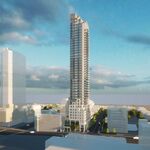There no doubt a degree of edifice -building by the railways back then - they all did it, but I'm not sure I would agree that stations were overbuilt. They were built for the needs of the day. When it was pushed through in the early part of the last century, the railway was the only practical means of transportation. Pretty much everything and everybody went in or out of the area by rail. The Ferguson Highway (Hwy 11) wasn't pushed through until the mid-1920s and in the beginning was a mud track a lot of the time and sections kept sinking away in the muskeg.
You mention Cobalt. According to Wiki, in 1909, there were 34 mines operating and it had a population of around 10,000. That's a lot of people and freight when you're the only game in town. That's a lot different than roughly 1,000 today (and shrinking).
I don't know for certain, but if they were like any other railway back then, there would have been multiple freight, passenger and mixed trains day and night. Back then, railways were labour intensive, so facilities were needed for passengers, train crews, dispatchers, station agent, freight handlers, section crews, yard crews, managers and supervisors, etc. Space was needed for baggage, mail, equipment, etc. Station had a role beyond passenger service.
My dad used to escort gold bars from Matachawan to the railhead at Elk Lake (interestingly, they left it on platform with the agent and returned, and never had a problem. He said if it had been a bottle of liquor it wouldn't have lasted 15 minutes).
Almost none of that is needed now. The proposed facilities will have a passenger-only role. The two large centres on the proposed route will have bricks-and-mortar stations, possibly twinned with ONR bus service and their municipal transit. Even at that I doubt they will be 24/7 operations. For a single train each way (maybe every day, maybe not, I'm not sure) there is absolutely no need, except in your mind and your mind alone, for millions to be spend on larger facilities. What the area residents need is a reliable travel alternative. What they don't need is costly add-ons that drive the project out of reach.
You're on this like tic. Yell at your MPP, lie down on tracks or hold your breath until you turn blue. I'm done.






